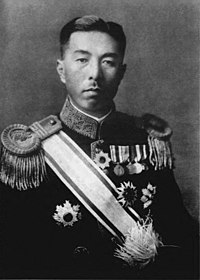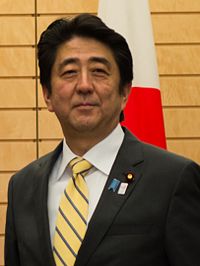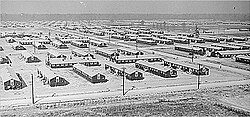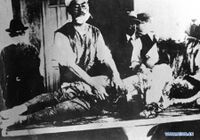Senrian Genocide
| Senrian Genocide | |
|---|---|
| Part of the Senrian-Xiaodongese War | |
 The corpses of Senrian civilians killed by Xiaodongese forces at the Sinzouku Extermination Zone. | |
| Location | |
| Date | April 10 1928-June 16 1932 (4 years, 2 months and 6 days) |
| Target | Ethnic Senrians |
Attack type | Genocide, ethnic cleansing, mass murder |
| Deaths | 9,500,000 (avg. independent estimate) 1,000,000 (Xiaodongese estimate) 15,000,000 (Senrian estimate) |
| Motive | Scientific racism, ethnic nationalism, Anti-Senrian sentiment |
The Senrian Genocide (Senrian: 썬류우대갸꾸싸뚜, Senryuu daigyakusatu; Xiaodongese: 千龙国种族灭绝, Qiānlóngguó zhǒngzú mièjué), known in Senria as the Unforgivable Crime (Senrian: 유루싸러내뚜미, yurusarenai tumi) and in Xiaodong as the Senrian Massacre (Xiaodongese: 千龙国惨案, Qiānlóngguó cǎn'àn), was the systematic extermination of an estimated nine and a half million Senrians by the Heavenly Xiaodongese Empire during the Senrian-Xiaodongese War. The genocide is conventionally said to have begun on April 10, 1928, when Xiaodongese troops began interning Senrian civilians in the Itinoseki Extermination Zone, and to have ended on June 16, 1932, when the Senrian Republican Army forced invading Xiaodongese troops off of Senrian soil.
The genocide took place during the Xiaodongese occupation of Senria. Xiaodongese troops in occupied Senria systematically rounded up Senrian prisoners of war and civilians, imprisoning them in concentration camps known formally in Xiaodongese as "rodent removal zones" but commonly known as "execution zones". Between 1927 and 1932, sixty-one such camps were constructed by occupying forces. Within these camps, interred Senrians were used primarily for slave labor, producing supplies for Xiaodongese forces in Senria; prisoners were routinely beaten and tortured, intentionally starved, housed in crowded and unsanitary barracks, and grossly overworked. Many prisoners were also subjected to human experimentation, including vivisections, lobotomies, and biological and chemical weapon testing. Prisoners deemed "no longer of use" were executed; while most prisoners were shot or bayoneted, the use of other methods- including live burial, gassing, and death by burning- was recorded. Many more prisoners died of starvation or disease, or were simply worked to death. Later in the conflict, as Senrian troops began to make large advances and liberated many of the extermination zones, Xiaodongese troops resorted to utilizing death marches to murder large numbers of detainees, with Senrian civilians simply forced to march to a rural area, shot en masse by Xiaodongese troops, and buried in mass graves.
The Xiaodongese government's initial end goal was to deport the vast majority of the Senrian population and resettle the Senrian archipelago with ethnic Xiaodongese, eventually annexing it into Xiaodong proper. Leading Xiaodongese officials of this era- notably Ren Xilian and Qiu Hanjie- were heavily influenced by the writings of Xiaodongese supremacists, including Jiang Yunshan, Zhang Qiemei, and Lin Yongsheng, who viewed ethnic Senrians as inherently inferior to ethnic Xiaodongese and had variously proposed their Xiaodongization, deportation, or outright extermination. However by April 1928 combination of increasing radicalization from the lower rungs of the occupation force, an influx of poorly educated ultranationalist conscripts in the occupation zone, a higher leadership intent on a quick solution to the "Senrian problem", and the increasingly powerful Senrian resistance movement led the Xiaodongese occupation authorities to implement a policy of explicit total extermination which aimed to cull the entire Senrian population, with genocide being approached on a systematic and institutionalised level. Had Xiaodong won the Senrian-Xiaodongese War, most analysts believe the genocide would have continued and expanded, with the potential death toll reaching as high as 45,000,000 Senrians. However, Senria's victory in the conflict prevented this.
The genocide remains a tense point between Senria and Xiaodong into the present. Senria continues to demand the ¥1,450,000,000,000 ($12,608,695,652) in reparations for the genocide stipulated by the Treaty of Keisi, in spite of Xiaodong's unilateral abrogation of the treaty 82 years ago. Denial or gross minimization of the genocide has been a crime in Senria since 1939, punishable by a fine of up to ¥1,150,000 ($10,000) and imprisonment ranging from three months to ten years. Some have also accused Senria- which maintains that 15,000,000 people were killed- of inflating the number of victims. Xiaodong, by contrast, maintains that only 1,000,000 were killed by Xiaodongese forces and has thus been widely accused of minimization of the genocide; many hardline Xiaodongese politicians have been accused of denying the genocide altogether. The overwhelming majority of independent sources agree that the Senrian Genocide did occur, with the majority estimating that around 9,500,000 Senrians were killed. There is also controversy of whether the genocide was pre-planned or occurred as a result of wartime pressures by occupation authorities.
Background
The Senrian genocide traces it way back to the development of Xiaodongese nationalism during the 1800's. Up until 1866 Xiaodong was ruled by the Toki Sougunate, an ethnically Senrian bakufu whilst many Xiaodongese thinkers became influenced by nationalist thought. These nationalists perceived the Toki as occupying forces and blamed Senrian culture and people on Xiaodong's underdevelopment. In 1758 proto-nationalist Zhao Zhiguo compared Senrians to leeches and called for them to be expelled from Xiaodong lest they further plunge Xiaodong into "anarchy and social collapse".
Anti-Senrian sentiment was codified into Xiaodongese nationalist thought by Jiang Yunshan in the Code of Benevolence. Jiag stated that Senrians of being naturally barbaric and that Xiaodongese people were blessed with natural traits of filial piety which he claimed led to a harmonious, morally pure society. Jiang called for Xiaodongese domination of lesser races "of which the Senrian is most prominent".
The Baiqiao Revolution saw the Toki overthrown by Xiaodongese nationalists who created the Heavenly Xiaodongese Empire. Much of these nationalists were vehemently anti-Senrian and promoted a form of Xiaodongese supremacism which was subsequently promoted and became widespread within Xiaodong.
Xiaodongese supremacism
During the early years of the Heavenly Empire whilst anti-Senrian sentiment and ultranationalism were present in Xiaodongese society the conception of Xiaodongese supremacism was largely absent. The most significant development until the 1900's was criminologist Ye Zhisui's claim in 1889 that prostitution, vagrancy, violence and sodomy were "inherited crimes" of which the Senrian race was more prone to than others. The development of Xiaodongese supremacism became more prevalent during the 1900's when right-wing nationalist groups such as the Society for the Emperor's Wellbeing and the Greater Xiaodong Study Group started to become popular, calling for the expansion of Xiaodong and subjugation of Senria.
<imgur thumb="yes" w="250" comment="A Xiaodongese poster from 1924 stating 'only under Xiaodong can Borea prosper'.">KQV2z9Q.jpg</imgur>
Political instability in 1909 led to the assumption of power of Zhao Hongjun, a military officer who had close links with the Society for the Emperor's Wellbeing. Zhao appointed Doctor Zhou Kuang Minister of Propaganda. Dr Zhou alongside deputy minister Ren Xilian formulated the idea of a Greater Xiaodong Order - that Xiaodong was destined to unite the nations of east Borea under its leadership in the interests of autocracy, peace and co-development. Zhou stated however that "barbarian races" such as Senrians who were seen to oppose the order had to be eliminated or controlled for its success, with Zhou stating "the Senrian is weak and degenerate, more comparable to a rat than a man. It is Xiaodong's duty to rule over these people's, as the Xiaodongese people alone have the moral purity and societal harmony to develop and prosper". Dr Zhou also brought in several right wing writers such as Chen Ruoqing, Lin Yongsheng, Jiang Yibo and Zhou Kuang to formulate theories on Xiaodongese supremacism. There propagandists claimed that Xiaodong was a superior nation racially to the others in the area especially Senria and that it was Xiaodong's duty to lead such nations; just propaganda was soon taught in Xiaodongese schools, within the military and within the civil service whilst media was taught to encourage it.
In 1912 Lin Yongsheng claimed that there existed a natural order that mandated that stronger, superior races were obliged to wipe out weaker races. Identifying Xiaodongese people as a "strong race" and the Narmadi, Duljunese and Senrians as "weak races", Lin claimed "if Xiaodong does not take the inevitable but necessary burden of wiping out the Senrian race before to long then our values will be destroyed by barbarity".
Xiaodongese supremacism became more prominent following the Senrian revolution. Jiang Yibo remarked in 1923 that "Of the nations of the orient, only Xiaodong and Tuthina have not fallen to a degenerate republicanism...yet Tuthina has failed to reform to fit current realities, and so will fall in the next decade...as such, it is Xiaodong's destiny to lead the Monic world and save it from westernism and barbarism". Chen Ruoqing was more explicit in Xiaodong's support for the annexation of Senria stating "if Senria is to continue in its current state of anarchy, then it will surely represent a great loss for civilisation if Xiaodong does not impose order in that land. Only under Xiaodongese tutelage can the Oriental people's prosper, starting with the most barbaric of them , the Senrian."
Whilst Xiaodongese supremacism was supported by Zhao Hongjun's government, Zhao had failed to act upon such principles due to his belief that Xiaodong was then unready to occupy such large parts of the Borean continent. However in 1922 Zhao was dismissed by the Shanrong Emperor who subsequently appointed prominent Xiaodongese supremacists - such as Qiu Hanjie and Ren Xilian - to high positions of government. Whilst not acting on Xiaodongese supremacism Zhao's support of it and the creation of Xiaodongese surpemecist groups (such as the Legion of Xiaodongese Youth and the National Association for Patriotic Mothers) meant that the ideology was firmly embedded in the government, military and population as a whole.
Ethnic cleansing in Xiaodong prior to 1927
Within the Heavenly Empire prior to 1927 Xiaodong utilised a complex system of racial divisions. The only major ethnic cleansing prior to the ascent of Zhao Hongjun were pogroms unleashed on Senrian nobles during the Baiqiao Revolution, albeit this was also done to pro-Toki Xiaodongese nobles. Within "periphery territories" - most importantly the satellite state of Narmada - where non-Xiaodongese made up the majority, the Xiaodongese government implemented a system of racial segregation wherein the Xiaodongese settler class was placed above the natives, but there was no major ethnic cleansing or removal of non-Xiaodongese people within the territory. Rather instead a system of forced labour - where natives had to fill a quota every year for the colonial authorities - was implemented in order to ensure obedience. Historian V. P. Maharatna states that under Xiaodongese rule "within Namrada there wasn't ethnic cleansing...people were to be used as resources rather than denigrated as sub-human as occurred in Senria". These forced labour policies also existed in much of Duljun.
Following the annexation of the Senrian city Sakata into Xiaodong in 1909, the new government approved on the cultural destruction of several historical sites and ordered the burning of several books. In 1912 the Sakatan colonial government passed the "Anti-Burakumin Laws" which approved of the deportation of burakumin people to ghettos where they were subsequently shipped over as slaves to Xiaodong.
The first large-scale ethnic cleansing policies attempted by Xiaodong began towards the Duljunese population in 1922. The-Minister of Racial Harmony Qiu Hanjie in response to the Mayor of Rongzhuo's opposition to Duljunese communities in the city due to "persistent violent behaviour and moral barbarity" created the Peace Preservation Brigades (治安保护队; Zhì'ān bǎohù duì) whose purpose was to clear the Duljunese out of the city.
Azkuri genocide
Most of the motivations and events behind the Senrian genocide were developed due to Xiaodongese ideology and the events of the Senrian-Xiaodongese War. However, some Xiaodongese officers and elites did take inspiration from the Azkuri genocide in their actions. The Azkuri genocide was at the time recorded by Xiaodongese ambassadors in Ankoren, despite relations in the two countries being strained. Xiaodongese diplomatic staff such as Li Zhaozheng were impressed at the "strong measures" being taken against the "rebellious" Azkuri people, with death marches being of particular being seen as effective. Xiaodongese nobleman Jiang Yongquan remarked that the Ankoreni ethnic cleansing of Azkuri's showed that the depopulation of an entire territory was achievable whilst in 1928 Qiu Hanjie remarked that "who...speaks today of the Ankoreni annihilation of the Azkuri's?" when discussing the depopulation policy in the occupied territories.
Qiu's comments on the Azkuri genocide have led to some to debate the influences these had on the later Senrian genocide. Although there were similarities, and death marches specifically were known to have been largely copied from Ankoreni actions most historians such as Kazuo Imamura have said that the Senrian genocide "was not mainly motivated by previous ethnic cleansing... while the genocides of the Azkuri convinced Xiaodongese officials they could carry out policies of genocide without repercussion, and inspired some of the methods of murder used, the initial plans for the genocide of the Senrian people ultimately arose from the racism and expansionism espoused by the Heavenly Empire... the Senrian Genocide was ultimately Xiaodongese in origin".
Movement towards war
Development and execution
The development of the Senrian genocide has been hotly debated between historians. Many have argued that the genocide was pre-planned in its entirety, pointing to policy proposals and speeches made by Xiaodongese politicians such as Zhao Hongjun, Ren Xilian and Qiu Hanjie that confirm Xiaodong aimed to wipe out the Senrian population, especially Ren's assertion in 1920 that Xiaodong should oversee "the orderly and complete dismantlement of Senria and the elimination of its peoples". Historians Tokutarou Izumi and Hirosige Nakano stated that the evidence for a pre-planned genocide was overwhelming, manifesting itself in the words and actions of both the Xiaodongese government during the period and the actions of the Xiaodongese military and occupation authorities.
However, other historians have noted that there is no evidence that genocide in of itself was planned. Early Xiaodongese proposals focused on the relocation of Senrian citizens to designated areas, and that it was pressures within the occupied zone combined with a radicalised bureaucracy that led to the development of a genocide. Xiaodongese historian Wang Decheng stated the genocide planned and implemented by occupation authorities and local military units during the occupation itself rather than the central government, but that the genocidal mentality came from ultranationalist rhetoric promoted by Xiaodongese politicians. Many have counter-argued that the plans for mass relocation would have qualified as genocide nevertheless, noting that the massive population dislocations called for in plans of forced resettlement would have likely resulted in hundreds of thousands of deaths.
Perpetrators
The direct perpetrators of the Senrian Genocide where the Peace Preservation Brigades, a paramilitary unit that came under the direct command of the Chief of Staff and head of the occupying forces in Senria, Qiu Hanjie. Qiu had as Minister of Racial Harmony had led efforts to ethnically cleanse Duljunese people within Xiaodong and was a well known proponent of anti-Senrian ideology within the government. The Peace Preservation Brigades themselves recruited predominantly from rural peasants who often received little education and were subject to ideological testing to ensure total obedience. The Brigades also included a scientific research unit and provided commissars for the regular military.

During his time as the Viceroy of occupied Senira Qiu passed several decrees that explicitly ordered members of the Peace Preservation Brigades to murder Senrian civilians, leading to many to compare the Brigades to death squads. The clear link between Qiu's decrees and the Peace Preservation Brigades actions have led to almost all historians to conclude the fact that Qiu and the Brigades were the main perpetrators of the genocide.
The role of the Heavenly Army has often been unclear. As extermination zones were under the direct command of the Peace Preservation Brigades, the army officially did not contribute to the acts of genocide within them, whilst generals such as Lu Keqian and Liao Yinzhi criticised the re-direction of resources from the frontlines to the extermination zones. However the Heavenly Army did take part in "sweeping" operations (where civilians were deported to extermination zones) and operated some of the early POW camps. Historian Wang Decheng stated that it has been common amongst historical revisionists to paint the army as being unaware of the genocide, whilst in reality army commanders were well aware of what was taking place often feigning indifference or support.
There exists heated debate on the role of the central Xiaodongese government during the genocide and if they promoted a "policy of genocide". The Xiaodongese government under the Shanrong Emperor and Prime Minister Ren Xilian never passed a policy explicitly calling for the creation of extermination zones and prior to 1928 had promoted several policies such as forced Xiaodongeseisation, deportations and genocide - however in a speech to the House of Industry in 1930 the Shanrong Emperor stated "my conscience is clear; by 2000 the Senrian race will be a footnote in the history of Xiaodong" whilst Ren notably called for "the orderly and complete dismantlement of Senria and the elimination of its peoples" earlier in his career in 1920. Historian Yu Chenghui stated that even if the Shanrong Emperor had not conceived a policy of genocide, his prior promotion of anti-Senrian sentiment and his wholehearted support of the occupation forces "makes it clear where his sympathies lay".
Senrian collaborators played a limited role in the genocide. The Army for the National Defence of Senria, a militia group created as the military arm of the pro-Xiaodongese National Association for a New Senria, was used in sweeping operations and to patrol camps. Xiaodongese commanders recruited former Senrian police officers to serve within extermination zones whilst some Senrian prisoners within the extermination zones were promoted to enforce order amongst prisoners. Otuzi Yosito at his trial in 1933 stated that the collaborationist government had been told by the Xiaodongese that they were merely clearing out "degenerates, traitors and criminals" from cities and were unaware of the Xiaodongese occupaton forces true intentions.
Early extermination zones (1927-1928)
Program expansion (1928-1930)
Senrian resistance
Massacres (1930-1932)


Death marches

Retaliation
Liberation
Trials
Victims
Aftermath
Recognition
Denial
Denial of the Senrian genocide continues to be a controversial topic and has been identified as a key factor in the poor relations between contemporary Senria and Xiaodong. Xiaodong has never recognised that its actions between 1928-1932 constitute a genocide, with the Xiaodongese government officially stating that the deaths were as a result of a series of unconnected massacres by rogue elements of the Xiaodongese military.

Genocide denial typically rests on the assertions that there was no "policy of genocide" ordered by the central government; that many of the massacres and extermination zones were in fact set up by Senrian authorities to intern opponents of the Senrian government and re-purposed for propaganda purposes; that starvation in extermination zones was a result of the Senrian-Tuthinian embargo; that most extermination zones were evacuation camps; and that most records of the genocide were fabricated by the Senrian government for political purposes.
Several high-ranking Xiaodongese politicians - such as former First Minister Yuan Xiannian ad current Second Minister Xu Bangguo - have questioned the authenticity of the genocide. Since education reform in 2007 many observers have stated that Xiaodongese children are taught to deny the Senrian genocide and that within Xiaodongese public discourse there is "widespread support" for genocide denial. This has been replicated in turn by Xiaodong abroad condemning nations that recognise the Senrian genocide.
An inquiry in 2013 commissioned by the State Presidium of Xiaodong concluded that "what occurred in the Senria from 1928-1932 can only be seen as excesses...there was no policy of genocide nor genocidal intent by the Xiaodongese state or the Heavenly Army of Xiaodong". The inquiry's reports were widely condemned as an attempt to deny the genocide.















